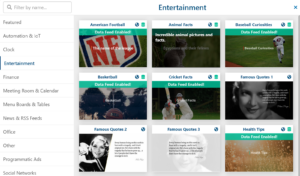A good digital signage message is like a traffic sign. It should be understood instantly and without much ambiguity. We all know the 5-second rule as the socially accepted duration of how long food can spend on the ground and still be consumed without seeming gross. It serves as a good rule of thumb for conveying meaning through quick messaging on your digital signage as well.
The challenge is to tell a whole world or meaning to the viewer in merely a few words. It’s a tricky goal, but once you nail down the methods on how to do it for your own unique audience, you’ll quickly see the benefits. Some messages are well known. For example, a discount on excess items is simply summed up in the word “clearance!” The viewers will immediately understand, and they also know to expect new items coming soon. Let the 5-second rule be your guideline to effectively convey a message on your digital signage. After all, it is very possible to design quick messaging which can be understood in a single second.
Keep in mind that, in the case of quick messaging on digital signage, you’re trading off some of the message and impact. Some things are not meant to be quickly understood. The story of a business or a charity cannot be condensed into just a few words. Parts of these stories, however, can be. “20 years of baking” or “10 million trees planted” are fragments which sum up the journey of a business quite well.
Implement quick wording
There are many ways you can increase the speed of comprehension for the viewer. Let’s start with the design. Eliminate excessive words in your message without compromising the quality and meaning behind it. For instance, “Shop now!” or “Sale!” are very short and understandable messages at a glance. They also help guide the viewer’s eyes and serve as a call to action. By making one primary word or message larger and putting it above others, the viewers immediately know what the sign is about. “30% Sale!” sounds exciting, and they already comprehend what the sign means. They will be more willing to explore longer messaging attached to it because they know what to expect.
In testing, you will know you’ve reached maximum comprehension speed, if your quick messaging on digital signage is understood at a glance. We’ll go over more examples below.
Establish clear visual elements
While your messaging might be clear, it is possible that your cluttered design and needless other visual elements are mudding the water. Use clear visuals and guide the viewer’s eyes to the most important parts of the display. Bold visuals should be reserved for the most important parts only. Contrast, both in the sense of color and mindset, is important.
Use familiar phrases
A great way to broadcast a message into the viewers’ brains with lightning speed is to use the knowledge they already possess. There are many words which are commonly used in advertising and sales messages. Words such as sale, discount, save, limited, free, offer, clearance, deal, now, new, and so on. As you read through them, you immediately see in which context they would be used. Some words depict excitement, such as “new” or “limited.” Others are more focused on the monetary aspect, such as “free,” “discount,” or “sale.” And there are some that are used to amplify the occasion further, such as “mega,” “super,” “hot,” or “massive.” Each of these words immediately injects the viewers’ brains with a vision, simply because they got so accustomed to seeing them used in specific contexts.
Nevertheless, always be truthful with your messaging. If a business puts up a banner that says “Save up to 90%,” it sounds amazing. If in reality, they put a 90% discount only on extremely cheap items which are not really best sellers, all it does is disappoint. When this type of overhyped messaging is repeated enough, the viewer will learn to distrust and ignore any further claims they see. That’s the worst possible scenario, because it gradually gnaws at your reputation. No messaging should sound like or—worst of all—actually be a lie. If it is, every next attempt will become more difficult, to a point where nobody trusts it at all.
Maintain a consistent style
Apart from relying on the knowledge your viewers already have, you can—for lack of a more appropriate word—train their brains to recognize your quick messaging. Here’s an example with a supermarket. Its storefront digital displays mainly consist of new products and a summary of the latest prices. The supermarket then chooses to run a big 7-day promotion with a reward for every purchase over $100. As the typical content is rather slow-moving, this promotion can be more aggressive and flashy, jumping onto the screen with a big sign that says “7-DAY SALE” with a big stylized exclamation point in the center. It appears sporadically and informs the viewers about the details. Seven days later, the promotion is done. The next one that runs, whatever it may be, has different text, but is similar in style and wording.
The viewers will learn to recognize this as a limited deal they can get excited about. They will gradually learn the style you use, enabling them to quickly identify the sign as something very exciting. This will boost comprehension speed and raise engagement. Again, as long as the quick messaging on your digital signage actually points to actually exciting deals, it will work. If you start using the same style to promote less-exciting deals and offers, the effect will fade.
Establishing a style which works is an important first step. With digital signage software, you can experiment with visuals, color palettes, and app combinations to ensure the message reaches the viewers easily within far less than five seconds. Start experimenting and explore the possibilities with OnSign TV!
Cover image by Karolina Grabowska.







